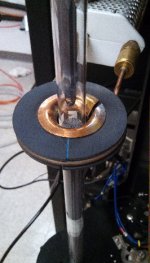JeepHammer
Moderator
HD, you are more or less correct...
Don't underestimate the home built units, with a market this small...
Start with the small portion of the world's population that are regular shooters, a small portion of those reload, a much smaller portion of those consider annealing, and an even smaller portion of those actually try annealing, and even smaller portion educate themselves on the process to do it correctly, no matter what process they choose (induction, resistance, gas, thermal mass, etc).
And then there is that very tiny fraction that try electrical induction annealing.
And keep in mind with a small fraction actually annealing and NOT accepting the results from common use/practice (usually wrong),
Then the even smaller portion that will educate themselves enough to build their own machine...
Then, and ONLY then, they build machines for sale.
Figuring they have invested a ton of time & money in the education, they introduce a product to a tiny fractional market...
Doesn't matter if it's electrical, gas, load (hot load/heat transfer, lead pots, heated dies, etc).
Keep in mind not even the big reloading equipment manufacturers offer an annealing machine (RCBS, Hornady, Lee etc), you are dealing with VERY small market, not even they are interested...
Every currently available machine is a really small company making them, a version they cooked up at home. Again doesn't matter how it's powered.
So taking offense at home built machines falls apart pretty quickly when you break it down.
No matter what you buy it's just a slicked up version of a home built machine since General Dynamics (or like company) isn't going to look at a market that isn't a billion dollars in sales a year...
I don't discount anything unless I've personally beat it with a stick in the shop and rolled the rock round instead of just turning every rock over.
It's not discounted until I've picked it apart...
Just like your favorite machine,
All magnetic induction machines use the same principle (electro-magnetic induction).
All magnetic induction machines are adjustable, simply by timing exposure to the magnetic field, or by initial power supply input (Volts/Amps).
All machines have some sort of movement limiting/spacing.
Either by holding the brass & coil/Ferrite fairly precisely.
Depending on power output, absloute precise spacing often won't matter as much,and as can be easily proven, lower power provides a more desirable anneal.
You either want a machine that is 'Plug & Play' and you don't want to mess with building or experimenting, which is entirely a personal choice.
Or you want more precise results which require experimentation and fiddling with vairables.
Don't underestimate the home built units, with a market this small...
Start with the small portion of the world's population that are regular shooters, a small portion of those reload, a much smaller portion of those consider annealing, and an even smaller portion of those actually try annealing, and even smaller portion educate themselves on the process to do it correctly, no matter what process they choose (induction, resistance, gas, thermal mass, etc).
And then there is that very tiny fraction that try electrical induction annealing.
And keep in mind with a small fraction actually annealing and NOT accepting the results from common use/practice (usually wrong),
Then the even smaller portion that will educate themselves enough to build their own machine...
Then, and ONLY then, they build machines for sale.
Figuring they have invested a ton of time & money in the education, they introduce a product to a tiny fractional market...
Doesn't matter if it's electrical, gas, load (hot load/heat transfer, lead pots, heated dies, etc).
Keep in mind not even the big reloading equipment manufacturers offer an annealing machine (RCBS, Hornady, Lee etc), you are dealing with VERY small market, not even they are interested...
Every currently available machine is a really small company making them, a version they cooked up at home. Again doesn't matter how it's powered.
So taking offense at home built machines falls apart pretty quickly when you break it down.
No matter what you buy it's just a slicked up version of a home built machine since General Dynamics (or like company) isn't going to look at a market that isn't a billion dollars in sales a year...
I don't discount anything unless I've personally beat it with a stick in the shop and rolled the rock round instead of just turning every rock over.
It's not discounted until I've picked it apart...
Just like your favorite machine,
All magnetic induction machines use the same principle (electro-magnetic induction).
All magnetic induction machines are adjustable, simply by timing exposure to the magnetic field, or by initial power supply input (Volts/Amps).
All machines have some sort of movement limiting/spacing.
Either by holding the brass & coil/Ferrite fairly precisely.
Depending on power output, absloute precise spacing often won't matter as much,and as can be easily proven, lower power provides a more desirable anneal.
You either want a machine that is 'Plug & Play' and you don't want to mess with building or experimenting, which is entirely a personal choice.
Or you want more precise results which require experimentation and fiddling with vairables.
Last edited:

